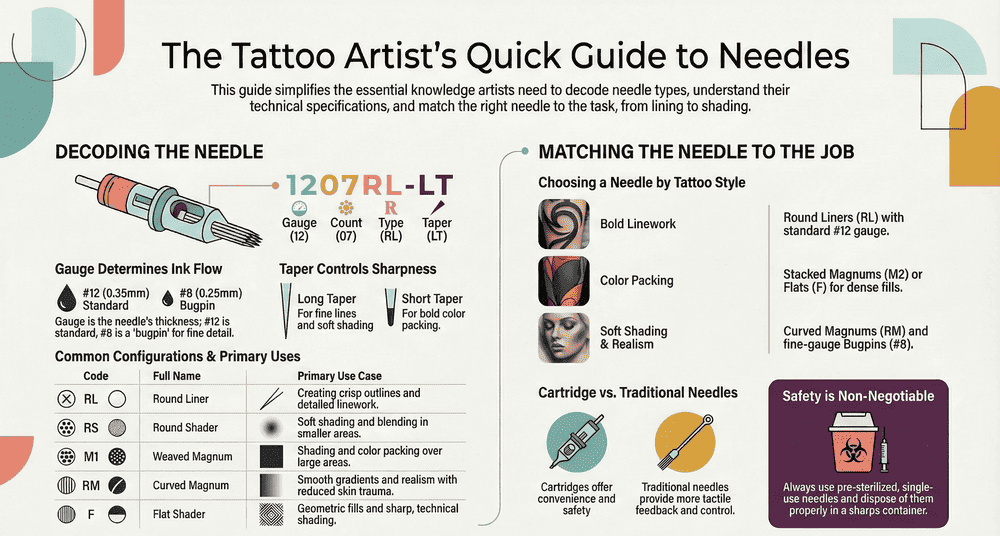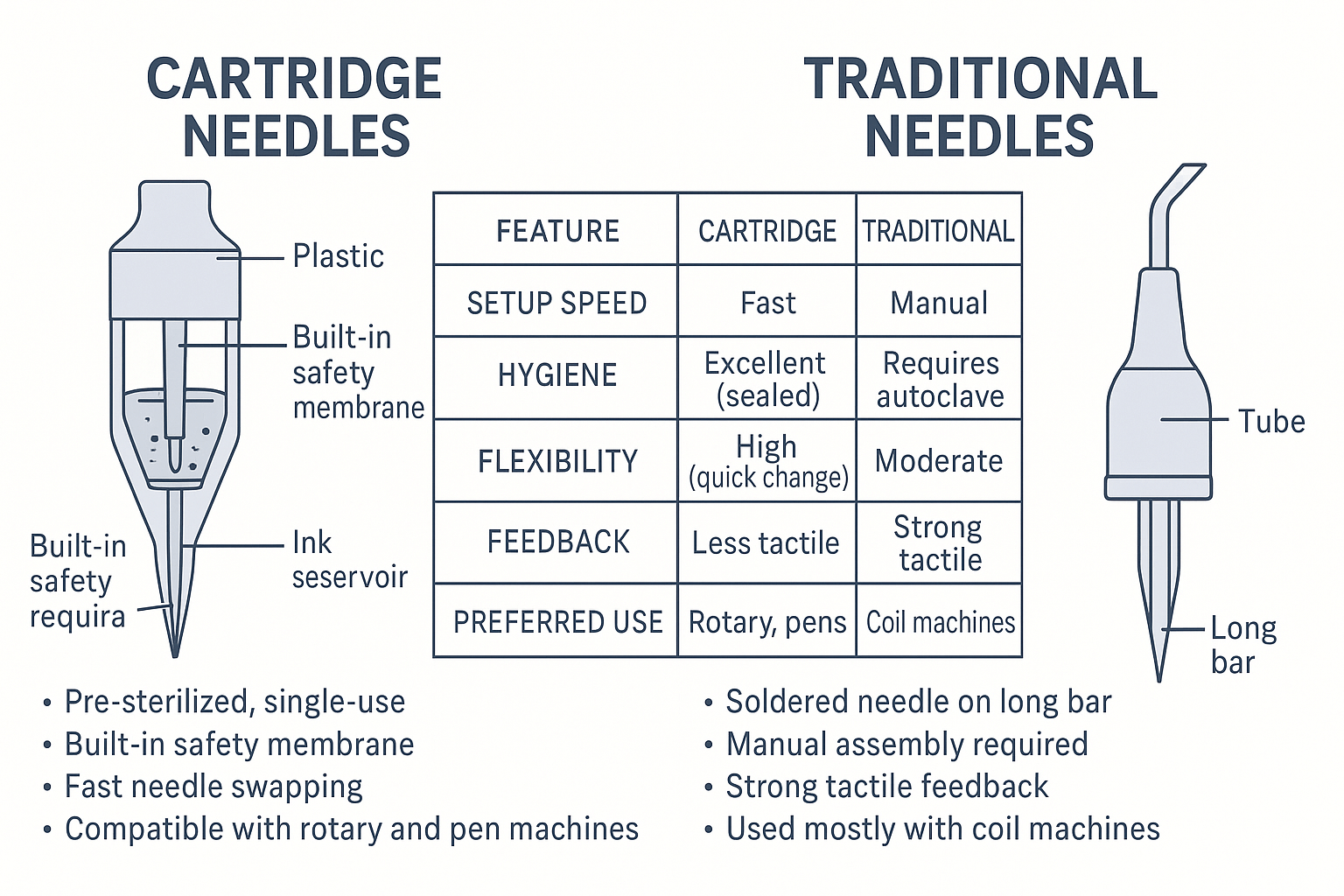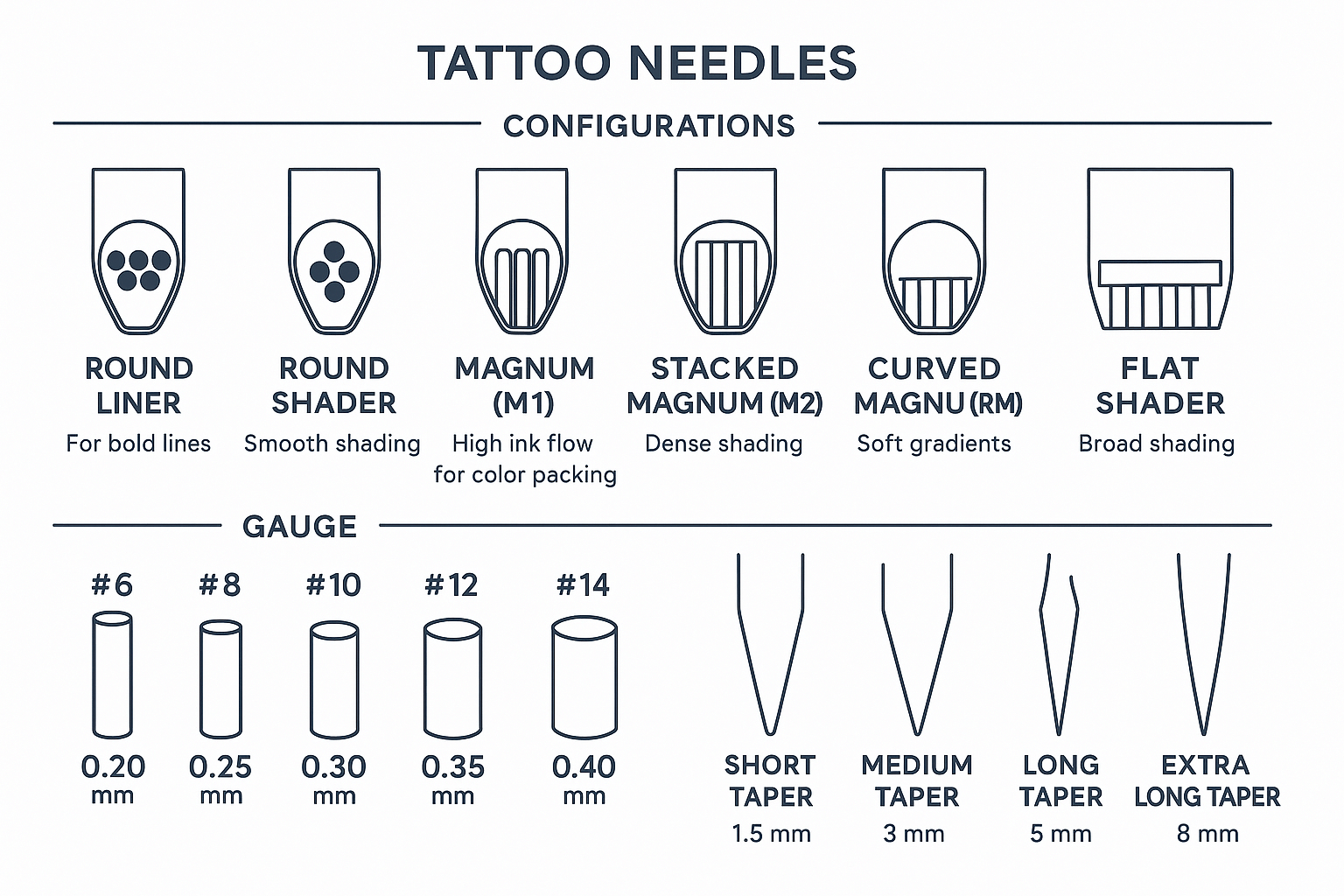Everything About Tattoo Machine Needles: A Complete Guide for Artists

Tattoo machine needles are the foundation of every great tattoo—whether it’s a bold traditional design, a delicate script, or a hyper-realistic portrait. Yet, for many artists, especially beginners, understanding the technical aspects of needle types, sizes, and configurations can be overwhelming. The right needle not only determines the quality of the ink deposit but also affects skin trauma, healing time, and overall client satisfaction.
This comprehensive guide demystifies tattoo needle codes, explains the differences between needle groupings like round liners and curved magnums, and provides expert insight into selecting the best tattoo needles for specific techniques—from lining and shading to realism and color packing. Whether you're setting up your first machine or refining your craft with premium equipment, knowing how tattoo needles work and how to choose them effectively is essential.
In this article, you’ll learn how to read tattoo needle sizes and configurations, why bugpin needles matter, how deep a tattoo needle should go, and what distinguishes cartridge needles from traditional setups. If you're ready to master your needle game and make smarter decisions for each tattoo you create, read on.
What Are Tattoo Needles and How Do They Work?

Tattoo needles are not single-point instruments but groupings of multiple micro-needles soldered together in specific configurations. These groupings determine how ink is deposited into the skin and directly affect the outcome of the tattoo. Unlike a sewing needle, tattoo needles do not inject ink like a syringe. Instead, they work by rapidly puncturing the skin’s dermis layer while the machine’s motion creates a capillary action that draws ink downward into the perforated skin.
Understanding how tattoo needles work is fundamental for both safety and technique. The depth of penetration is critical—typically between 1 and 2 millimeters—to avoid blowouts or scarring. For a full breakdown of how to set the correct needle depth for every tattoo style, check out How to Know the Correct Tattoo Needle Depth. Too shallow and the ink won’t hold; too deep and it could cause lasting skin damage.
Tattoo needles are made of stainless steel and undergo strict sterilization processes. High-quality, professional tattoo needles are EO gas sterilized and are either single-use disposable or part of sterilizable traditional setups. For professionals using rotary or pen-style machines, cartridge tattoo needles offer convenience, hygiene, and stability, especially when paired with premium machines.
When selecting needles, understanding their construction, movement, and role in the skin allows artists to improve precision, reduce trauma, and achieve better ink saturation across styles and techniques.
Tattoo Needle Groupings and Configurations Explained

Tattoo needle groupings refer to how individual needle points are arranged and soldered. This configuration defines the needle’s purpose—lining, shading, coloring—and is the basis for many key decisions an artist must make before starting a tattoo. Understanding these groupings is essential for choosing the right tool for the job.
Round Liner (RL)
Round liner needles have their points tightly grouped in a circular pattern. They are the best tattoo needles for lining, used to create crisp outlines, intricate lettering, and dot work. Common sizes include 3RL, 5RL, and 9RL—higher numbers mean more needles and thicker lines. When comparing 3RL vs 5RL, the latter offers a bolder stroke with wider ink flow.
Round Shader (RS)
Similar in appearance to round liners, round shader needles have slightly looser spacing between the tips. This makes them suitable for soft shading, color blending in small areas, and fill-ins. Artists often ask about round liner vs round shader needles — the key difference lies in their spacing and intended use: liners for outlines, shaders for smooth tonal transitions.
Magnum (M1) and Stacked Magnum (M2)
Magnum tattoo needles consist of two stacked rows of needles, usually arranged in a weaved (M1) or tightly packed (M2) formation. They cover large areas efficiently and are favored for color packing and shading. Stacked mags (M2) provide denser fills, making them ideal for bold color work.
Curved Magnum (RM)
Curved magnum needles — also called soft edge or round magnums—feature a slight arc in the needle tip. This reduces trauma by allowing smoother movement along the skin, especially useful in realism and black and grey styles. Many artists prefer curved magnum vs standard magnum due to the soft blending and reduced skin resistance.
Flat Shader (F)
Flat shader tattoo needles align their points in a single horizontal row. This formation delivers solid fills and is commonly used in geometric tattoos, heavy shading, and technical line work. Flat needles offer maximum ink saturation per pass and are effective for straight-edge techniques.
Specialty Configurations
- Bugpin tattoo needles use thinner gauge needles (often 0.25 mm or smaller), resulting in slower ink flow and high detail precision. This is why they’re popular in portrait work and realism.
- Hollow liners and double stacks offer even more variation for artists seeking specific effects, though they are less commonly used.
Choosing the right configuration depends on tattoo style, skin type, and machine compatibility. A well-informed decision improves ink delivery, speeds up sessions, and results in better-healed tattoos. Up next: how needle size and gauge further influence your setup.
Tattoo Needle Sizes Explained: Diameter, Gauge, and Taper
Tattoo needle sizes play a critical role in ink flow, line thickness, and skin trauma. These specifications are commonly encoded in the needle’s label, but understanding the tattoo needle sizes explained in detail will help you make informed decisions about what to use and when.
Diameter and Gauge
The diameter, also known as the gauge, refers to the thickness of each individual needle point. It directly affects how much ink is deposited and how deep the needle penetrates. The most common gauges include:
| Gauge | Diameter | Common Use |
|---|---|---|
| #6 | 0.20 mm | Extremely fine work |
| #8 | 0.25 mm | Known as bugpin; ideal for detail and portrait tattoos. |
| #10 | 0.30 mm | Balanced flow; versatile for lining and shading |
| #12 | 0.35 mm | Standard size; best for bold lines and color packing |
| #14+ | 0.40+ mm | Heavy coverage; less common |
What is a bugpin needle? Bugpin tattoo needles are finer than standard needles, allowing for ultra-smooth gradients and subtle tonal work. Many artists consider them essential in black and grey and portrait tattoos due to their precision.
Taper Length
The taper is the length of the needle's pointed tip. It determines how sharp the penetration is and how gradually the needle deposits ink. Taper length affects both control and ink flow.
- Short Taper (1.5 mm) – more ink per puncture; great for solid fills and color packing
- Medium Taper (2.5–3.5 mm) – balanced performance for lining and shading
- Long Taper (5–7 mm) – ideal for smooth gradients and realism
- Extra Long Taper (8+ mm) – high precision; used for very fine lines and soft shading
- Textured Taper – grooved surface holds more ink; useful in textured tattoo needles for saturated black and grey styles

When artists explore the difference between 3RL and 5RL needles or 5RS vs 7RS, it often comes down not just to the number of needles but also the combination of diameter and taper. These subtle changes significantly affect line weight and shading density.
How to Read Tattoo Needle Codes and Understand the Numbers
If you've ever looked at a box of tattoo needles and felt confused by the string of numbers and letters, you're not alone. Learning how to read tattoo needle codes is essential for selecting the correct needle for your machine and technique. The code typically includes four pieces of information: needle count, configuration, diameter, and taper.
What Do the Numbers on Tattoo Needles Mean?
Consider this common example: 1207RL-LT
- 12 – This indicates the gauge. In this case, 12 = 0.35 mm diameter (standard).
- 07 – This is the needle count. It means the grouping contains 7 needle points.
- RL – This stands for Round Liner, identifying the tattoo needle configuration.
- LT – This refers to the taper length (Long Taper).
This code tells you you're working with a 0.35 mm round liner needle, grouped with 7 points, and a long taper for refined line work.
Understanding these codes helps artists compare needles like 9M1 vs 9RM, where M1 refers to a straight magnum, while RM (round magnum) indicates a curved configuration better suited for softer blends.
Tattoo Needle Configuration Chart (Quick Reference)
| Code | Meaning | Use Case |
|---|---|---|
| RL | Round Liner | Outlines, crisp details |
| RS | Round Shader | Soft fills, blending small areas |
| M1 | Weaved Magnum | Color packing, large shading zones |
| M2 | Stacked Magnum | Dense packing, bold fills |
| RM | Curved Magnum | Smooth blends, realism |
| F | Flat | Geometric fills, sharp shading |
By learning these standard labels, artists avoid mismatched setups and make precise decisions based on the tattoo’s needs and client’s skin type. Whether choosing the best tattoo needles for shading, lining, or color packing, the code is your roadmap.
How to Choose Tattoo Needles: A Practical Guide for Artists
Selecting the right tattoo needle isn’t just about technical specs—it’s about matching the tool to your style, skin type, and machine. Whether you're working on bold lines, smooth shading, or detailed portraits, knowing how to choose tattoo needles will enhance both your efficiency and final results.
Consider the Tattoo Style
- Linework: use round liners (RL) with #10 or #12 gauge and a medium-to-long taper for crisp outlines. For fine lines, a 3RL with a long taper offers excellent control.
- Shading: opt for round shaders (RS) or magnums (M1/M2). For soft gradients, curved magnums (RM) are the best choice.
- Color Packing: go with stacked magnums (M2) in higher counts (9 or above) and thicker gauges (#12), especially with a short taper for faster ink saturation.
- Realism and Portrait Work: choose bugpin tattoo needles (#8 or finer) with a long or extra-long taper. These provide the smoothest transitions in shading and fine detail.
- Traditional Tattoos: use round liners for bold lines and flat shaders (F) for strong color fills and solid black areas.
Match Needle to Machine and Grip
- For rotary and pen-style machines, cartridge tattoo needles are ideal due to their convenience and compatibility with quick-change systems.
- For coil machines, traditional bar needles may provide better feedback for experienced artists.
Adapt to Skin Type and Body Area
Thin, delicate skin (e.g., inner arm, neck) benefits from finer needles and longer tapers to reduce trauma. For thicker or textured skin (e.g., back, chest), medium-to-large groupings help deposit ink effectively without excessive pressure.
Trial and Adjustment
Choosing tattoo needles involves a learning curve. Many professional sets or tattoo needle starter kits offer mixed configurations—perfect for experimenting and refining your setup. As you gain experience, you’ll find which needle types feel most natural in your hand and deliver consistent results.
Whether you're a beginner or upgrading to professional-level work, knowing which tattoo needle for thick lines or which needle to use for portrait shading allows you to create with confidence. If you're just getting started, don't miss our beginner-friendly article: Tattoo Tips for Beginners by Vlad Blad Irons Team. Up next: how cartridges compare to traditional needles—and which system may suit you best.
Cartridge Tattoo Needles vs Traditional Needles: Which Should You Use?
One of the most significant decisions modern tattoo artists face is choosing between cartridge tattoo needles vs traditional bar needles. Both systems offer unique advantages, and the right choice depends on your workflow, machine type, and hygiene standards.
Learn more about compatible machines in our guide to Top Rotary Tattoo Machines by Vlad Blad.
Cartridge Needles: Convenience and Safety
Cartridge needles are single-use, modular systems that contain the needle, housing, and membrane in one unit. They’re especially popular among rotary and pen-style machine users.
Advantages:
- Quick swapping: ideal for multitasking between linework, shading, and color packing without reassembling the machine.
- Built-in safety membranes: prevent ink or blood from flowing back into the grip or machine.
- Consistent manufacturing: many premium brands ensure precision, making them excellent for tattoo needles for realism and detailed work.
- Compact setup: great for traveling artists or studios with strict hygiene requirements.
Best used for: Artists using rotary machines, those prioritizing speed and hygiene, and professionals working in mixed styles.
Traditional Needles: Precision and Feedback
Traditional needles are soldered to a long bar and used with coil or compatible rotary machines. They require manual assembly with the appropriate tube and grip.
Advantages:
- Mechanical feedback: preferred by artists using coil machines for their tactile response and control.
- Cost-effective: more economical when purchased in bulk or professional tattoo needle sets.
- Broader range of configurations: offers more control over individual needle and tube pairing.
Best used for: Artists comfortable with manual setup, especially in traditional tattoo styles or where precise coil machine calibration is preferred.
Are All Tattoo Needles Universal?
No. While many needles follow standard sizes, not all are interchangeable. Cartridges must match the machine’s grip type, and traditional needles require specific tubes and grips for proper alignment and hygiene. Understanding these compatibility rules helps avoid costly mistakes.
Tattoo Needle Hygiene, Sterilization, and Disposal
Proper hygiene is non-negotiable in tattooing. Tattoo needles pierce the skin thousands of times per session, and even minor lapses in cleanliness can lead to serious health risks for both clients and artists. Whether you're using disposable tattoo needles, cartridges, or traditional setups, safety protocols must be followed rigorously.
How to Sterilize Tattoo Needles
Disposable needles come pre-sterilized with EO (ethylene oxide) gas and should always be used straight from sealed, date-stamped packaging. Never reuse these needles.
For non-disposable traditional needles, sterilization must be performed using an autoclave. This process uses high-pressure steam to kill all pathogens. However, in most modern studios, disposable systems are now standard, and reusing needles—even sterilized—is generally discouraged.
Can You Reuse Tattoo Needles?
No. Reusing needles increases the risk of cross-contamination, even with sterilization. Additionally, reused needles lose sharpness, leading to more skin trauma and poor ink retention. Professional standards demand one-use-only needles.
How to Dispose of Tattoo Needles
Used needles must be discarded in FDA-approved sharps containers — rigid, puncture-proof boxes designed for biohazard waste. Never throw used needles into the trash or recycle bin. Tattoo shops are required to follow local health regulations for medical waste disposal.
Key Safety Tips
- Always check the expiration date and integrity of packaging before use.
- Don’t trust generic suppliers — buy tattoo needles online only from reputable sources.
- Never use bent, dull, or poorly soldered needles, as they can damage skin and cause blowouts.
Maintaining a sterile environment is as important as artistic skill. In the next section, we’ll wrap up with a summary of the key takeaways and how to choose your ideal needle setup based on style, skin, and machine.
Choosing the Right Tattoo Needles for Precision, Safety, and Style
Mastering tattoo needle selection is one of the most impactful ways to elevate your craft. Whether you're a beginner exploring your first tattoo needle starter kit or a seasoned artist optimizing setups for realism or bold traditional work, understanding the nuances of tattoo needle sizes, configurations, and gauges is essential.
Key takeaways include:
- Learn the codes: knowing how to read tattoo needle codes saves time and prevents mistakes.
- Match needle to task: use round liners for outlines, magnums for shading, and bugpins for fine detail.
- Mind the gauge and taper: these affect ink flow, trauma, and healing.
- Cartridge or traditional? choose based on your machine, workflow, and hygiene standards.
- Prioritize safety: only use disposable tattoo needles from trusted sources and follow correct needle disposal procedures.
From textured tattoo needles for color packing to fine tapers for portrait realism, every choice you make as an artist reflects in your results. As equipment evolves, staying informed empowers you to achieve consistent, clean, and safe work on every canvas.
For premium needle sets, trusted brands, and hygienic cartridge systems, explore our curated selection of professional tattoo supplies. Whether you're refining your linework or expanding your shading techniques, your ideal needle configuration starts with the right tools—and the right knowledge.
Still choosing your first machine? Read our Best Tattoo Machine for Beginners guide to match your needle preferences with the right equipment.
